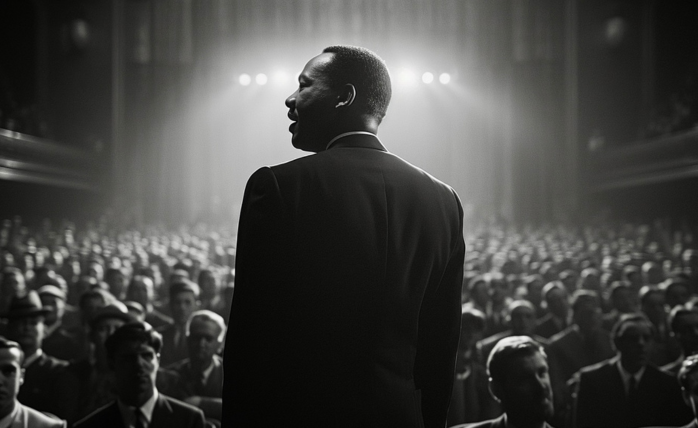Entrepreneurs
Lessons We Can All Learn From Martin Luther King Jr.’s Leadership
While reflecting on the magnificent life of Dr. Martin Luther King Jr. I began to uncover what truly made Dr. King such a powerful leader

While reflecting on the magnificent life of Dr. Martin Luther King Jr. I began to uncover what truly made Dr. King such a powerful leader. Many revere him for the change he brought forth so it’s no wonder that he was heavily influenced by the man who said, “Be the change you want to see in the world”. He embodied that statement on the deepest level and lead people through one of the most challenging yet historic times in our nation.
But what was it that made Dr. King’s movement so different than the rest? A quality that transcends ego and unites a people so divided?
My greatest and most moving discovery while studying the life of Dr. King was the very answer to our question.
Yes, he had the personality to be a leader, yes he had the bravery to use his voice, yes he evoked REAL change in government and policies, but the manifestation of all those comes from his willingness to lead a movement truly rooted in consciousness.
A peaceful approach
Dr. King was continuously met with frustration, hate, and even violence by both law enforcement and those who wanted to fight for equality through violence. But the more violent things became, the more he dug his heels into a peaceful approach. Dr. King’s unwavering faith in the power to lead with peace and not violence is undoubtedly why his legacy is such a pillar of our nation still to this day. It is easier to fight.
Hate, anger and separateness from one another are primitive emotions on the emotional scale of well being but It takes awareness, understanding and elevated consciousness to move from a place of peace and understanding. Dr. King knew that we all have access to these states of higher consciousness and that our true power lies in a peaceful approach.
He is an example of the truest essence of our consciousness in this human experience. How to truly love your neighbor as yourself.
Conscious compassion
“Even the strongest opponents are human. Meet hate with love + compassion for the enemy” he said. It wasn’t his resistance to violence that made him a peacemaker, but rather his commitment to keeping compassion and connection to all humanity at the forefront of his movement. A profound understanding that underneath all the hate, violence and discrimination, we are all one. We all come from the same source and we are all human.
A conscious king
A man of his position, his power, his following could have been easily swayed by the human temptations of the ego. But he remained steadfast in his cause to bring forth real change. He understood on the deepest level that we are truly a stronger force in the universe when we move as one unit, with one mind, and one goal. That the separation from one another is the weakness of humanity. That our strength is in those things that unite us all, the qualities that give us life.
His success was in uniting not just the people of America but the consciousness of America.
No matter our gender, or our social class or our color, we all love, and we all seek peace. We all feel joy and happiness, we all want to be met with compassion and understanding.
His cause went far beyond the need for physical freedom and equal rights. His cause was for freedom of mind, freedom of heart, freedom to be one.
Lead with love
In his last speech he said, “I may not get there with you, but we AS A PEOPLE will get to the promise land”. And we will. At some point, we will inevitably come back to this oneness that we all come from.
The truth is? We don’t know when our last day is. Our last march. Our last speech. So this Martin Luther King Jr. Day I ask you, what will your legacy be? Are you leading a life founded in the principles of Dr. King’s movement, founded in the higher consciousness of humanity? Every moment is an opportunity to love, to show compassion, to bring forth peace and in the words of Dr. King “The time is always right to do what is right”.
Dr. King said, “I’m here to remind you, we’ve come a longggg way, but there is still work to be done”.
And I’m here to remind you this Martin Luther King Jr. day in 2024 that we HAVE come a longggg way, but there is still work to be done.
His fight is our fight. His mind is our mind. His spirit is our spirit. Rooted in the consciousness of all humanity. We are all one. And when we embrace the understanding of that, we will truly say
“Free at Last, Free at Last, Thank God Almighty, We are Free at Last”.
Change Your Mindset
The Silent Skill That Makes People Respect You Instantly
What truly earns respect and why most people go about it the wrong way

Everybody craves respect but not everyone earns it. Some people believe that a title, years of experience, or a position of authority automatically entitles them to respect. (more…)
Entrepreneurs
The Essential Skills Every Entrepreneur Needs In 2026
Success in the digital age isn’t about luck. It’s about mastering the skills that separate dreamers from doers.

When I was 22 years old, I started my first side hustle as a ghostwriter. (more…)
Business
The Hidden Money Pit in Your Operations (and How to Use It)
See how smart asset management software is quietly saving businesses thousands in wasted time, stock, and maintenance.

Trimming unnecessary expenses and minimizing resources is a general practice in running a business effectively. Asset management software can help you achieve those goals. (more…)
Business
Thinking of Buying A Business? These 6 Sectors Quietly Produce the Best Deals
Before you buy your next venture, check out the sectors where successful businesses are changing hands every day.

All entrepreneurs have a desire to be the masters behind a successful venture. Buying an established business is a great choice for many. This provides instant access to an established market with existing infrastructure and clients. (more…)
-

 Business4 weeks ago
Business4 weeks agoWhy Your E-Commerce Fulfilment Is Probably Broken (And How to Fix It)
-

 Shift Your Mindset3 weeks ago
Shift Your Mindset3 weeks ago11 E’s That Define Every Great Leader And Why Most People Miss Them
-

 Did You Know3 weeks ago
Did You Know3 weeks agoThe Success Patterns You Inherited (And Didn’t Notice)
-

 Business3 weeks ago
Business3 weeks agoThe Hidden Money Pit in Your Operations (and How to Use It)
-

 Entrepreneurs2 weeks ago
Entrepreneurs2 weeks agoThe Essential Skills Every Entrepreneur Needs In 2026
-

 Change Your Mindset2 weeks ago
Change Your Mindset2 weeks agoHow to Turn Your Mind Into Your Greatest Asset (Instead of Your Enemy)
-

 Change Your Mindset1 week ago
Change Your Mindset1 week agoThe Silent Skill That Makes People Respect You Instantly
-

 Life6 days ago
Life6 days ago10 Research-Backed Steps to Create Real Change This New Year


























